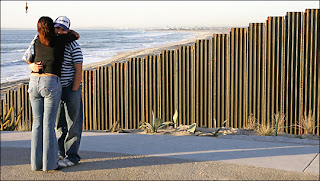The seals had been decapitated. They lay there,
bloated and shiny, basking in the sun as it leaked through clouds that
cluttered the sky. Neither of the two seals looked dead; their corpses mocked
life. Their fins were too erect, their waterproof skin too golden. It wasn’t
until your scanning eyes reached the top of their bodies that you realized that
instead of dark, bright eyes closed against the sun, a thin backbone discolored
with blood and dried muscle tendons poked out from their short necks. Then your
eyes looked more carefully.
The first seal had been shot in the stomach. It had
not died of natural causes, unless you count the propensity for useless killing
possessed by the humans that do these things as natural. The second seal had
gone the same way. I shivered as I gazed at the identical bullet hole. Though
high tides had come and gone, washing over the bodies, a ring of watered-down
blood still circled the holes. I thought of all of the decapitated bodies that
had been dug up from mass graves along the border in the past year; migrants
killed viciously, impassively. It was a mounting death toll forced by
gratuitous violence. Money, guns, drugs, power.
Many details of this landscape of the San Diego/Tijuana borderlands seem
to mock not life itself, but the way in which humans have decided to experience
it. The birds here in the border backcountry fly unchallenged over green
marshes, and the dolphins swim uninhibited through the waters beyond the trail,
but two separate fences keep people from moving freely across the infamous San
Diego-Tijuana border.
The fences run into the sea. Maria, one of the women in our group of 10
that has driven to Friendship Park for a language exchange across the border
fence, tells me that once, children on either side would swim near the shore.
It didn’t matter what country they started in: boys from Tijuana and children
from San Diego would paddle against currents and end up 10 feet across the line
delineated on land without being arrested or even reprimanded. Now, the
concrete pillar that thrusts itself into the sky on our side bearing cameras
(though not a machine gun, as I imagine while looking at it) insures that this
is not the case. I can see smoke from barbecues and colorful beach umbrellas on
Playas de Tijuana. I’m sad I cannot make the fence melt into the sand, walk
over, and introduce myself. I wonder if there is an invisible line that splits
the sea here.
At first I hadn’t understood Isabel (the Volunteer Coordinator for the
non-profit Border Angels, which I volunteered with last summer) in her indignation
at the second fence being installed by the government to create a space of
about 30 feet between Mexico and the U.S. Though I am a proponent of immigrant
rights and my volunteer work put me in direct contact with “illegal aliens” (a
term I abhor), my logical self likes to keep the equation balanced. I must
fight for the basic human rights of all, but I must also grant the government a
certain measure of understanding, I tell myself. Surely it is a crime to allow
people to die crossing the desert, but at the same time we can’t simply open
our borders, no holds barred. What about the practical reasons for maintaining
a physical distance between the two countries, such as prevention of drug deals
through the wooden slats of the fence? But after visiting this portion of it,
guarded by multiple armed officers, I realize that these concerns are not
valid. No one would risk being caught by the border patrol for a petty drug
deal, which is the only scale that could occur under such close watch (not to
mention the practical difficulty of shoving kilos of cocaine through a one-inch
space between boards). What criminal would smuggle their goods in such an
inefficient manner, with such drastic possible repercussions for such minimal
possible payoff?
The second fence does more than just physically separate the U.S. and
Mexico. It alienates an entire country, its culture, and its people from its
neighbors. In building that second, arbitrary fence, the U.S. government says
no to civilized dialogue and thoughtful, purposeful actions to truly reform not
only immigration policy, but arms policy and drug policy which feed the violence
and poverty cycles in Mexico that drive scores of Mexican citizens over the
border in the first place.
Photo: Couple embracing on the Mexican side of the border mentioned above
Omar Torres/AFP/Ghetty Images


Katie, this is haunting and very accurate. Well done!
ReplyDeleteThanks Diana! I would love to hear your informed, academic opinion on the border & drugs etc.
ReplyDelete